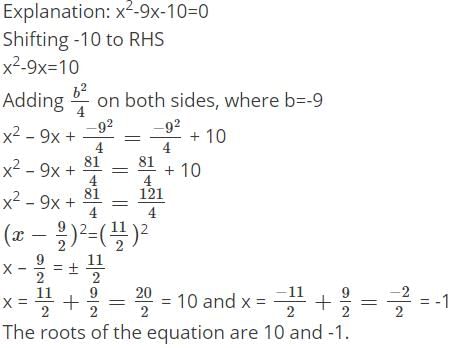Quadratic & Higher Order Equations Important Notes | Quantitative Aptitude (Quant) - CAT PDF Download
The theory of equations is an essential part of algebra, dealing with linear, quadratic, and higher-order equations. It helps in understanding how equations are formed, solved, and applied in mathematics as well as real-life problems. This document introduces the basic concepts, standard forms, and solution methods for different types of equations, with special focus on quadratic equations and the relation between their coefficients and roots.
Theory of Equations
An equation is a valid mathematical statement that includes an equal sign ( = ), indicating that the expressions on both sides are equal. By solving these equations, we can determine the values of unknown variables, known as roots.
1. Linear Equation Formula
- A linear equation can be expressed in the form: ax + b = 0, where a and b are real numbers, and x is the variable. This is the standard representation of a linear equation. It is important to note that the variable used is not always x.
- In a linear equation, there is only one root, denoted as p, which can be calculated using the formula:

2. Quadratic Equation Formula
- A quadratic equation involves the second degree of the variable, indicating the presence of at least one squared term. The standard form of a quadratic equation is: ax2 + bx + c = 0, where a, b, and c are constants, and x is the variable to be evaluated. It is essential that the coefficient a is not equal to zero.
- The quadratic equation is a fundamental concept in algebra. When the roots of the equation are p and q, the following relationship holds:
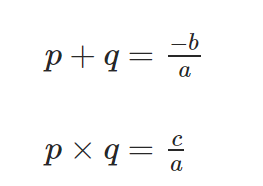
3. Cubic Equation Formula
- A cubic equation has the highest degree of the variable as 3. Its standard form is: ax3 + bx2 + cx + d = 0, where a, b, c, and d are coefficients, with the condition that a must not be zero.
- According to the fundamental theorem of algebra, a cubic equation has three roots, considering multiplicities, which may be real or complex. Let the roots be p, q, and r. Then the following relationship holds:
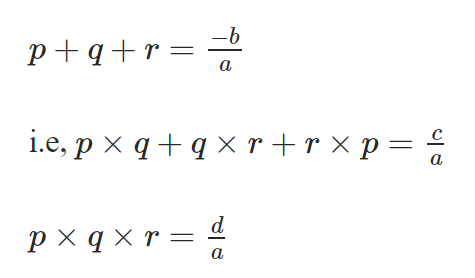
Quadratic Equations
Quadratic equations are the polynomial equations of degree 2 in one variable of type f(x) = ax2 + bx + c where a, b, c ∈ R and a ≠ 0.

- The general form of a quadratic equation has ‘a’ as the leading coefficient (the coefficient of x²) and ‘c’ as the constant term (the term without x). The values of x that satisfy the quadratic equation are called the roots (α, β).
- A quadratic equation always has two roots, which can be either real or complex. The nature of these roots can differ.
- A quadratic polynomial becomes a quadratic equation when it is set to zero. The values of x that satisfy the equation are known as the roots of the quadratic equation.
- General form: ax 2 + bx + c = 0. Examples: 3x 2 + x + 5 = 0, -x 2 + 7x + 5 = 0, x 2 + x = 0.
Important Formulas for Solving Quadratic Equations
1. Roots of Quadratic Equations: The roots of a quadratic equation can be found using the formula: x = (-b ± √D) / (2a), where D is the discriminant given by D = b 2 - 4ac.
2. Nature of Roots: The nature of the roots depends on the value of the discriminant (D):
- D > 0: The roots are real and distinct (unequal).
- D = 0: The roots are real and equal (concurrent).
- D < 0: The roots are imaginary and unequal.
3. Conjugate Roots: If the roots are of the form (α + iβ) and (α - iβ), they are conjugates of each other.
4. Sum and Product of Roots: For a quadratic equation with roots α and β:
- Sum of roots (S) = α + β = -b/a = coefficient of x / coefficient of x 2
- Product of roots (P) = αβ = c/a = constant term / coefficient of x 2
5. Quadratic Equation in Terms of Roots:. quadratic equation can be expressed as: x 2 - (α + β)x + (αβ) = 0
6. Common Roots in Quadratic Equations: For the equations a 1 x 2 + b 1 x + c 1 = 0 and a 2 x 2 + b 2 x + c 2 = 0:
- One common root if (b 1 c 2 – b 2 c 1 ) / (c 1 a 2 – c 2 a 1 ) = (c 1 a 2 – c 2 a 1 ) / (a 1 b 2 – a 2 b 1 )
- Both roots common if a 1 /a 2 = b 1 /b 2 = c 1 /c 2
7. Minimum or Maximum Value in Quadratic Equations: For the quadratic equation ax 2 + bx + c = 0 or in the form [(x + b/2a) 2 - D/4a 2 ]:
- If a > 0, the minimum value is 4ac - b 2 /4a, occurring at x = -b/2a.
- If a < 0, the maximum value is 4ac - b 2 /4a, also occurring at x = -b/2a.
8. Roots of Cubic Equations: For a cubic equation of the form ax 3 + bx 2 + cx + d = 0, the relationships among the roots α, β, and γ are:
- α + β + γ = -b/a
- αβ + βγ + γα = c/a
- αβγ = -d/a
9. Identity in Quadratic Equations: A quadratic equation is considered an identity (with a, b, c = 0) if it holds true for infinitely many numbers, meaning it has infinite solutions if all coefficients are zero.
Quadratic Equation: Roots, Nature of Roots & Coefficient
1. Roots of a Quadratic Equation
The solution or roots of a quadratic equation are given by the quadratic formula:
(α, β) = [-b ± √(b2 – 4ac)]/2ac
- The values of variables satisfying the given quadratic equation are called its roots. In other words, x = α is a root of the quadratic equation f(x), if f(α) = 0.
- The real roots of an equation f(x) = 0 are the x-coordinates of the points where the curve y = f(x) intersects the x-axis.
- One of the roots of the quadratic equation is zero, and the other is -b/a if c = 0
- Both roots are zero if b = c = 0
- The roots are reciprocal to each other if a = c
- Discriminant: The term (b2 – 4ac) in the quadratic formula is known as the discriminant of a quadratic equation. The discriminant of a quadratic equation reveals the nature of the roots.
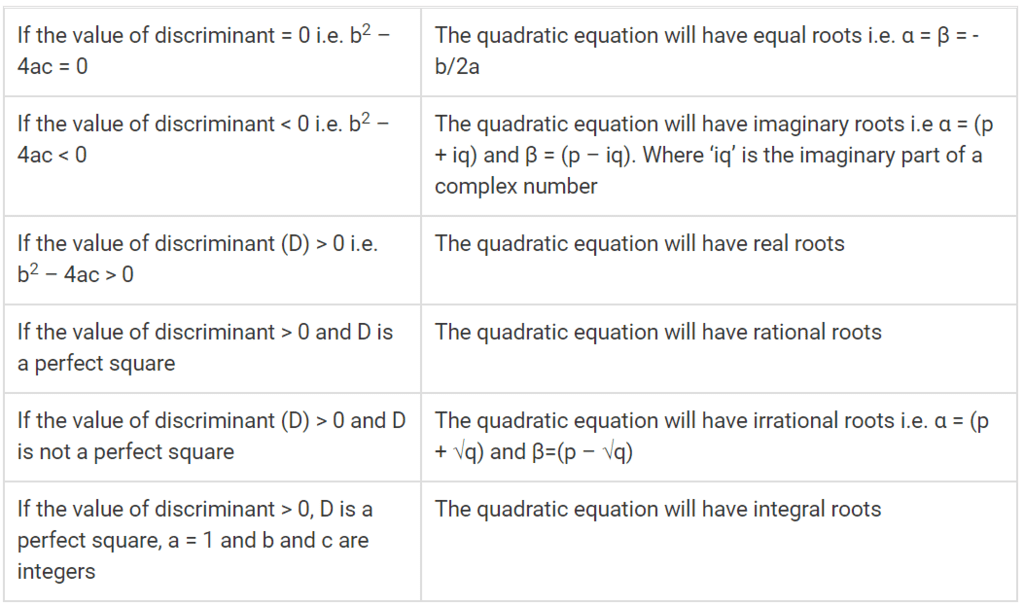
Nature of Roots of Quadratic Equation
2. Determination of the Nature of Roots of a Quadratic Equation
Let's see how to determine the nature of the roots of a quadratic equation through these solved examples:
Example 1: Find the values of k for which the quadratic expression (x – a) (x – 10) + 1 = 0 has integral roots.
- The given equation can be rewritten as, x2 – (10 + k)x + 1 + 10k = 0.
D = b2 – 4ac = 100 + k2 + 20k – 40k = k2 – 20k + 96 = (k – 10)2 – 4- The quadratic equation will have integral roots, if the value of discriminant > 0, D is a perfect square, a = 1 and b and c are integers.
i.e. (k – 10)2 – D = 4- Since discriminant is a perfect square. Hence, the difference of two perfect square in R.H.S will be 4 only when D = 0 and (k – 10)2 = 4.
⇒ k – 10 = ± 2. Therefore, the values of k = 8 and 12.
Example 2: Find the values of k such that the equation p/(x + r) + q/(x – r) = k/2x has two equal roots.
- The given quadratic equation can be rewritten as:
[2p + 2q – k]x2 – 2r[p – q]x + r2k = 0- For equal roots, the discriminant (D) = 0, i.e. b2 – 4ac = 0
Here, a = [ 2p + 2q – k ], b = – 2r [ p – q ] and c = r2k
[-2r (p – q)]2 – 4[(2p + 2q – k) (r2k)] = 0
r2(p – q)2 – r2k(2p + 2q – k) = 0- Since r ≠ 0, therefore, (p – q)2 – k(2p + 2q – k) = 0
k2 – 2(p + q)k + (p – q)2
k = 2(p+q) ± √[4(p + q)2 – 4(p – q)]2/2 = -(p + q) ± √4pq- ∴ The values of k = (p + q) ± 2√pq = (√p ± √q)2
3. Relationships between Coefficient and Roots of Quadratic Equation
If α and β are roots of a Quadratic Equation ax2 + bx + c, then:
- α + β = -b/a
- αβ = c/a
- α – β = ±√[(α + β)2 – 4αβ]
- |α + β| = √D/|a|
The relationship between the roots and the coefficient of a polynomial equation can be derived by simplifying the given polynomials and substituting the above results, as shown below:
- α2β + β2α = αβ (α + β) = – bc/a2
- α2 + αβ + β2 = (α + β)2 – αβ = (b2 – ac)/a2
- α2 + β2 = (α – β)2 – 2αβ
- α2 – β2 = (α + β) (α – β)
- α3 + β3 = (α + β)3 + 3αβ(α + β)
- α3 – β3 = (α – β)3 + 3αβ(α – β)
- (α/β)2 + (β/α)2 = α4 + β4/α2β2
Example 3: If the coefficient of x in the quadratic equation x2 + bx + c =0 was taken as 17 in place of 13, its roots were found to be -2 and -15. Find the roots of the original quadratic equation.
- Since there is no change in the coefficient of x2 and c, therefore, the product of zeros will remain the same for both equations.
- Therefore, the product of zeros (c) = -2 × -15 = 30,
Since, the original value of b is 13.- ∴ Sum of zeros = -b/a = -13.
- Hence, the original quadratic equation is:
x2 – (Sum of Zeros)x + (Product of Zeros) = 0
x2 + 13x + 30 = 0
∴ (x + 10) (x + 3) = 0- Therefore, the roots of the original quadratic equations are -3 and -10.
4. Quadratic Equations Having Common Roots
- Let β be the common root (solution) of quadratic equations a1x2 + b1x+c1 and a2x2+b2x+c2. This implies that a1β2 + b1β + c1 = 0 and a2β2 + b2β + c2 = 0.
- Now, solving for β2 and β, we will get:
β2/(b1c2 – b2c1) = -β/(a1c2 – a2c1) = 1/(a1b2 – a2b1) [using determinant method]
Therefore, β2 = (b1c2 – b2c1)/ (a1b2 – a2b1) . . . . . . . . . . . . . . . . (1)
And, β = (a2c1 – a1c2)/(a1b2 – a2b1) . . . . . . . . . . . . . . . . (2) - On squaring equation (2) and equating it with equation (1) we get:
(a1b2 – a2b1)/(b1c2 – b2c1) = (a2c1 – a1c2)2 - Hence, it is the required condition for quadratic equations having one common root.
If both the roots of quadratic equations a1x2 + b1x + c1 and a2x2 + b2x + c2 are common then:
a1/a2 = b1/b2 = c1/c2 - If α is a repeated root, i.e., the two roots are α, α of the equation f(x) = 0, then α will be a root of the derived equation
f’(x) = 0 where f’(x) = df/dx - If α is a repeated root common to f(x) = 0 and ϕ(x) = 0, then α is a common root to both f’(x) = 0 and ϕ ‘(x) = 0.
Let's see some solved examples to solve quadratic equations with common roots.
Example 4: For what value of k, both the quadratic equations 6x2 – 17x + 12 = 0 and 3x2 – 2x + k = 0 will have a common root.
- If one of the root of quadratic Equations a1x2 + b1x + c1 and a2x2 + b2x + c2 is common then: (a1b2 – a2b1)(b1c2 – b2c1) = (a2c1 – a1c2)2 . . . . . . . . . . . . . (1)
- Form the given quadratic Equations, a1 = 6, b1 = -17, c1 = 12, a2 = 3, b2 = -2 and c2 = k
- On substituting these values in equation (1), we will get:
[(6×-2) – (3×-17)] × [-17k – (-2×12)] = (3×12 – 6k)2
-663k + 936 = 1296 + 36k2 – 432k
36k2 + 231k + 360 = 0
12k2 + 125k + 120 = 0
(4k + 15) (3k + 8) = 0- Therefore, the values of k are -154, -83.
Example 5: Find the values of k such that the Quadratic Equations x2 – 11x + k and x2 – 14x + 2k have a common factor.
- Let (x – α) be the common factor of quadratic Equations x2 – 11x + k and x2 – 14x + 2k Then x = α will satisfy the given quadratic equations.
- Therefore, α2 – 11α + k = 0 . . . . . . . . . . (1)
And, α2 – 14α + 2k = 0 . . . . . . . . . . . . (2)- On Solving Equation (1) and Equation (2) we will get:
α2/(-22k + 14k) = -α/2k – k = 1/(-14 + 11)
Therefore, α2 = (-22k + 14k)/-3 = 8/3 . . . . . . . (3)
And, α = (2k – k)/(-14 + 11) = k/3 . . . . . . . . . . . (4)- On Equating Equation (3) and Equation (4):
8/3 = (k/3)2- Therefore, the value of k = 24.
Methods for Solving Quadratic Equations
There are two methods to solve a quadratic equation:
- Algebraic Method
- Graphical Method
1. Algebraic Method of Solving Quadratic Equations
General Form: ax2 + bx + c = 0;
⇒ x2 + bx/a + c/a = 0
⇒ (x + b/2a)2 = b2/4a2 – c/a
⇒ (x + b/2a)2 = (b2 – 4ac)/4a2
⇒ x + b/2a = ± (√b2 – 4ac)/2a
⇒ x = [-b ± √(b2 – 4ac)]/2a
b2 – 4ac = Discriminant (D)
α = (-b+√D)/2a
β = (-b – √D)/2a
α+β= -b/a, α.β = c/a
Therefore, the quadratic equation can be written as,
⇒ x2 – (α + β)x + (α.β) = 0.
Tips to Solve Equations reducible to Quadratic:
- To solve the equations of type ax4 + bx2 + c = 0, put x2 = y
- To solve a.p(x)2 + b.p(x) + c = 0, put p(x) = y.
- To solve a.p(x) + b/p(x) + c = 0, put p(x) = y.
- To solve a(x2 + 1/x2) + b(x + 1/x) + c = 0,put x + 1/x = y and to solve a(x2 + 1/x2) + b(x – 1/x) + c = 0, put x – 1/x = y.
- To solve a reciprocal equation of the type ax4 + bx3 + cx2 + bx + a = 0, a ≠ 0, divide the equation by d2y/dx2 to obtain a(x2 + 1/x2) + b(x + 1/x) + c = 0,and then put x + 1/x = y.
- To solve (x + a) (x + b) (x + c) (x + d) + k = 0 where a + b = c + d, put x2 +(a + b)x = y
- To solve an equation of type √(ax + b) = cx + d or √(ax2 + bx + c) = dx + e, square both the sides.
- To solve √(ax + b) ± √(cx + d) = e, transfer one of the radical to the other side and square both the sides. Keep the expression with radical sign on one side and transfer the remaining expression on the other side.
2. Graphical Solution of Quadratic Equation
- Consider a quadratic equation ax2 + bx + c = 0, where a, b, and c are real and a ≠ 0. The expression can be further rewritten as:
a[(x + b/2a)2 + (D/4a2)] - The above quadratic equation represents a parabola whose vertex is at P [-b/2a, -D/4a] and axis parallel to y-axis.
- In a quadratic equation, the value of ‘a’ determines whether the graph of a quadratic equation will be concave upwards (a > 0) or concave downwards (a < 0). The value of the discriminant (b2 – 4ac) determines whether the graph of a quadratic equation will:
(i) Intersect the x-axis at two points, i.e., b2 – 4ac > 0
(ii) Just touches the x-axis, i.e., b2 – 4ac = 0
(iii) Never intersects the x-axis, i.e., b2 – 4ac < 0
Graphing Quadratic Equations
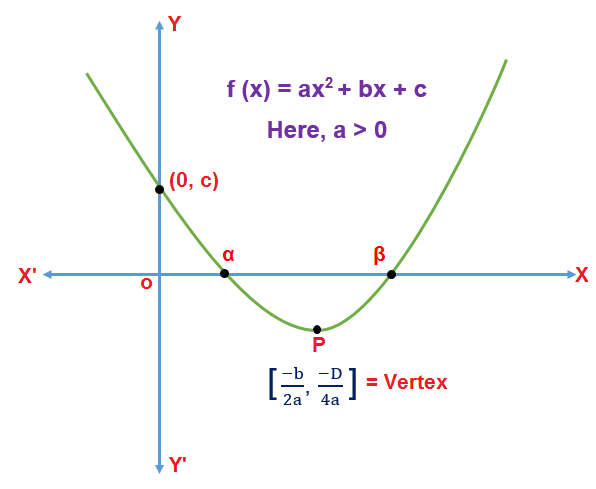
The quadratic equation represents a parabola with a vertex at P and an axis parallel to the y-axis.
Case 1: When a > 0 and b2 – 4ac > 0
- The graph of a quadratic Equation will be concave upwards and will intersect the x-axis at two points α and β with α < β. The quadratic equation will have two real roots (α and β), and the curve will always lie above the x-axis.
- The quadratic function f(x) will be positive i.e. f(x) > 0, for the values of x lying in the interval (-∞, α) ∪ (β, ∞)
- The quadratic function f(x) will be Equal to zero i.e. f(x) = 0, if x = α or β
- The quadratic function f(x) will be negative i.e. f(x) < 0, for the values of x lying in the interval (α, β)
Case 2: When a > 0 and b2 – 4ac = 0
- The graph of a quadratic equation will be concave upwards and will touch the x-axis at a point -b/2a.
- The quadratic equation will have two equal real roots, i.e., α = β. The quadratic function f(x) will be positive, i.e., 0 ≤ f(x), x ∈ R.
Case 3: When a > 0 and b2 – 4ac < 0
- The graph of a quadratic equation will be concave upwards and will not intersect the x-axis. The quadratic equation will have imaginary roots, and the curve will always lie above the x-axis.
- The quadratic function f(x) will be positive, i.e., f(x) > 0, x ∈ R.
Case 4: When a < 0 and b2 – 4ac > 0
- The graph of a quadratic equation will be concave downwards and will intersect the x-axis at two points α and β with α < β. The quadratic equation will have two real roots (α and β), and the curve will always lie below the x-axis.
- The quadratic function f(x) will be positive, i.e., f(x) > 0, for the values of x lying in the interval (α, β).
- The quadratic function f(x) will be equal to zero i.e. f(x) = 0, if x = α or β
- The quadratic function f(x) will be negative i.e. f(x) < 0 for the values of x lying in the interval (−∞, α) ∪ (β, ∞)
Case 5: When a < 0 and b2 – 4ac = 0
- The graph of a quadratic equation will be concave downwards and will touch the x-axis at a point -b/2a.
- The quadratic equation will have equal real roots, i.e., α = β. The quadratic function f(x) will be negative, i.e., f(x) ≤ 0, x ∈ R.
Case 6: When a < 0 and b2 – 4ac < 0
- The graph of a quadratic equation will be concave downwards and will not intersect the x-axis.
- The quadratic equation will have imaginary roots, and the curve will always lie below the x-axis. The quadratic function f(x) will be negative, i.e., f(x) < 0, x ∈ R.
Range of the Quadratic Equation
Consider a quadratic expression f(x) = ax2 + bx + c, where a ≠ 0 and a, b, and c are real. The quadratic expression can be further rewritten as f(x) = x2 + bax = ca. Intervals in which the roots of Quadratic Equation lie
Intervals in which the roots of Quadratic Equation lie
Case 1: Both the roots of a quadratic equation (α, β) are greater than any given number ‘m’ if,
- b2 – 4ac = (D) ≥ 0,
- -b/2a > m,
- f (m) > 0.
Case 2: Both the roots of a quadratic expression (α, β) are less than any given number ‘m’ if,
- b2 – 4ac = (D) ≥ 0,
- -b/2a < m,
- f(m) > 0.
Case 3: Both the roots of a quadratic expression (α, β) will lie in the given interval (m1, m2) if,
- b2 – 4ac = (D) ≥ 0,
- m1 < -b/2a > m2,
- f(m1) > 0,
- f(m2) > 0.
Case 4: If exactly one root of a quadratic equation (α, β) will lie in the given interval (m1, m2), then f(m1).f(m2) < 0
Case 5: The given number ‘m’ will lie between the roots of a quadratic Equation α and β if f(m) < 0
Case 6: The roots of a quadratic equation α and β will have an opposite sign if f(0) < 0.
Case 7: Both the roots of a quadratic expression α and β are positive if,
- b2 – 4ac = (D) ≥ 0,
- α + β = -b/a > 0,
- αβ = c/a > 0.
Case 8: Both the roots of a quadratic expression α and β are negative if,
- b2 – 4ac = (D) ≥ 0,
- 2. α + β = -b/a < 0,
- 3. αβ = c/a < 0.
Example 6: Find the range of k for which 6 lies between the roots of the quadratic equation x2 + 2(k – 3)x + 9 = 0.
- 6 will lie between the roots of the quadratic expression f(x) = x2 + 2(k – 3)x + 9 if,
f (6) < 0
i.e. 36 + 2 (k – 3) . 6 + 9 < 0,
= 36 + 12k – 36 + 9 < 0,
= k < -34- Therefore, the range of k for which 6 lies between the roots of the given quadratic equation is:
k ∈ (-∞, -34)
Maximum and Minimum Value of a Quadratic Equation
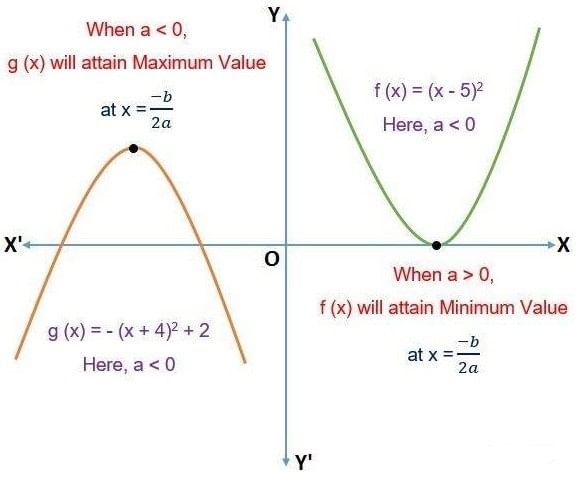 Conditions for Minimum and Maximum Value of Quadratic Equation
Conditions for Minimum and Maximum Value of Quadratic Equation
- To find the minimum value of a quadratic equation, we need to understand the nature of the graph of these equations for different values of ‘a’. The graph of the quadratic equation f(x) = ax2 + bx + c will be either concave upwards (a > 0) or concave downwards (a < 0) respectively.
- When the graph is concave upwards, then its vertex determines the minimum value of a quadratic function f(x), and when it is concave downwards, its vertex determines the maximum value of a quadratic function f(x).
How to Find Maximum and Minimum Values of Quadratic Functions?
Case 1
- When a > 0, the absolute range of a quadratic expression is given by:
[-b2 – 4ac/4a, ∞) or [-D/4a, ∞)
Case 2
- When a < 0, the absolute range of a quadratic equation is given by:
(-∞, -D/4a] - Also, the maximum and minimum values of a quadratic equation f(x) occur at x = -b/2a.
- If the given quadratic equation is in the form f(x) = a(x – h)2 + m, Then the value of ‘m’ (vertex) gives us the minimum (when ‘a’ is negative) or maximum (when ‘a’ is positive) values of the given function.
Maximum and Minimum Values in a Restricted Domain
Case 1
- -b/2a ∉ [m, n]
- f(x) = ∈ [ minimum {f(m), f(n)}, maximum {f(m), f(n)} ]
Case 2
- -b/2a ∈ [m, n]
- f(x) ∈ [minimum {f(m), f(n) – D/4a}, maximum {f(m), f(n), -D/4a}]
Example 7: Find the maximum or minimum value of the quadratic equation -4(x – 2)2 + 2.
- Since the value of ‘a’ is negative, therefore the given quadratic equation will have a maximum value.
- Hence, the maximum value of the quadratic equation -4(x – 2)2 + 2 is 2.
Example 8: Find the minimum and maximum values of the quadratic equation f(x) = x2 – 12x + 11.
- Since a > 0, the maximum and minimum values of a quadratic expression is given by:
[(-b2 – 4ac)/4a, ∞) or [-D/4a, ∞)- Therefore, the minimum value of f(x) is:
-(144 – 44)/4 at x = -(-12/2) = -25 at x = 6.- The maximum value of f(x) is infinity. Therefore, the range of the given quadratic equation is [- 25, ∞).
Descartes' Rule of Signs for Quadratic Polynomials
- This is a very famous rule that helps in getting an idea about the roots of a polynomial equation.
- The rule states that the number of positive real roots of Pn(x) = 0 cannot be more than the number of sign changes. Similarly, the number of negative roots cannot be more than the number of sign changes in Pn(-x).
Example 9: How many real roots does the equation 2x5 + 2x4 – 11x3 + 9x2 – 4x + 2 = 0 will have?
- The given equation has 4 sign changes so it can have a maximum of 4 positive real roots.
- Now for f(-x), the equation has only one sign change i.e. f (-x) = -x5 + 2x4 + x3 + x2 + x + 2 = 0. Hence, the equation will have only one negative real root.
Example 10: How many real roots does the quadratic equation x2 + 3|x| + 2 have?
- Since the quadratic equation has no sign change for both f(x) and f(-x). Therefore, the equation will have no real root.
- Sign Convention of Quadratic Equation – ax2 + bx + c = 0
- The roots of quadratic equation are equal in magnitude but of opposite sign if b = 0 and ac < 0
- The root with greater magnitude is negative if the sign of a = sign of b × sign of c
- If a > 0, c < 0 or a > 0, c > 0; the roots of quadratic equation will have opposite sign
- If y = ax2 + bx + c is positive for all real values of x, a > 0 and D < 0
- If y = ax2 + bx + c is negative for all real values of x, a < 0 and D < 0
Quadratic Equations in Two Variables
- The general form of a quadratic equation ax2 + 2hxy + by2 + 2gx + 2fy + c can be factorised into two linear factors as shown below,
ax2 + 2(hx + g)x + by2 + 2fy + c = 0 . . . . (i) - Using the quadratic formula in the above equation, we get,
x = [2(hy + g) ± √{4(hy + g)2 – 4a(by2 + 2fy + c)}]/2a
ax + hy + g = ± √(h2y2 + g2 + 2ghy – aby2 – 2afy – ac) . . . . (ii) - At this point, the expression (i) can be resolved into two linear factors if,
(h2 – ab)y2 + 2(gh – af)y + g2 – ac is a perfect square and h2 – ab > 0
But (h2 – ab)y2 + 2(gh – af)y + g2 – ac will be a perfect square if discriminant = 0
i.e. g2h2 + a2f2 – 2afgh – h2g2 + abg2 + ach2 – a2bc = 0 and h2 – ab > 0
abc + 2fgh – af2 – bg2 – ch2 = 0 and h2 – ab > 0 - This is the required condition. The condition that this expression may be resolved into two linear rational factors is:
abc + 2fgh – af2 – bg2 – ch2 = 0 and h2 – ab > 0 - This expression is called the discriminant of the above quadratic expression.
Cubic Equation
- A polynomial having degree three is known as a cubic polynomial, or we can call it a cubic equation.
- Cubic equations have at least one real root, and they can have up to 3 real roots.
- The roots of a cubic equation can be imaginary as well, but at least 1 must be real.
ax3 + bx2 + cx + d = 0
⇒ Sum of the roots = - b/a
⇒ Sum of the product of the roots taken two at a time = c/a
⇒ Product of the roots = -d/a - Example: Find the roots of the following cubic equation: 2x3 + 3x2 – 11x – 6 = 0
Solution:
To find: Roots of the given equation.
This equation can not be solved using the factorisation method; we will use the trial and error method to find one root.
We generally start with the value “1”.
f (1) = 2 + 3 – 11 – 6 ≠ 0
f (–1) = –2 + 3 + 11 – 6 ≠ 0
f (2) = 16 + 12 – 22 – 6 = 0
Value “2” makes the LHS equal to “0”. Hence, two is one of the three roots.
Now we will use the Synthetic Division Method to find the other two roots.
We divide our equation by (x-2), and the quotient will give us the other two roots. We divide our equation by (x-2), and the quotient will give us the other two roots.
Quotient : (2x2 + 7x + 3)
Factorising this quotient,
(2x+1) (x+3)
From here, we get the values of x as,
x = -1/2 and x = -3
Answer: So, the three roots of the cubic equation are x = 2, x = -1/2 and x = -3
Higher Degree Equations/ Biquadratic Equation
- A polynomial equation of degree four without the terms of degree three and one is known as a biquadratic equation.
- General Form: z4 + a0z2 + c = 0
Examples: (i) x4 +16x2 + 6 = 0
(ii) 2x4 + 14x2 + 3 = 0 - Biquadratic Equation ax4+bx3+cx2+dx+e = 0
⇒ Sum of the roots = - b/a
⇒ Sum of the product of the roots taken three at a time = c/a
⇒ Sum of the product of the roots taken two at a time = -d/a
⇒ Product of the roots = e/a
Let's see an example to solve Biquadratic Equations
Biquadratic polynomials can be easily solved by converting them into quadratic equations, i.e., by replacing the variable ‘z’ by x2.
Example 11: Find the zeros of a biquadratic equation x4 – 3x2 + 2 = 0.
- Given f (x) = x4 – 3x2 + 2
- On substituting x2 = z in the given equation we get,
f(x) = z2 – 3z + 2 = 0
z2 – 2z – z + 2 = 0
z(z – 2) -1(z – 2) = 0
∴ z = 1 and z = 2- Hence, x = ±√1 and x = ±√2 [Since, z = x²].
|
167 videos|238 docs|95 tests
|
FAQs on Quadratic & Higher Order Equations Important Notes - Quantitative Aptitude (Quant) - CAT
| 1. What is a quadratic equation? |  |
| 2. What are the roots of a quadratic equation? |  |
| 3. How can we determine the nature of the roots of a quadratic equation? |  |
| 4. What are the important formulas for solving quadratic equations? |  |
| 5. How can we solve quadratic equations? |  |


